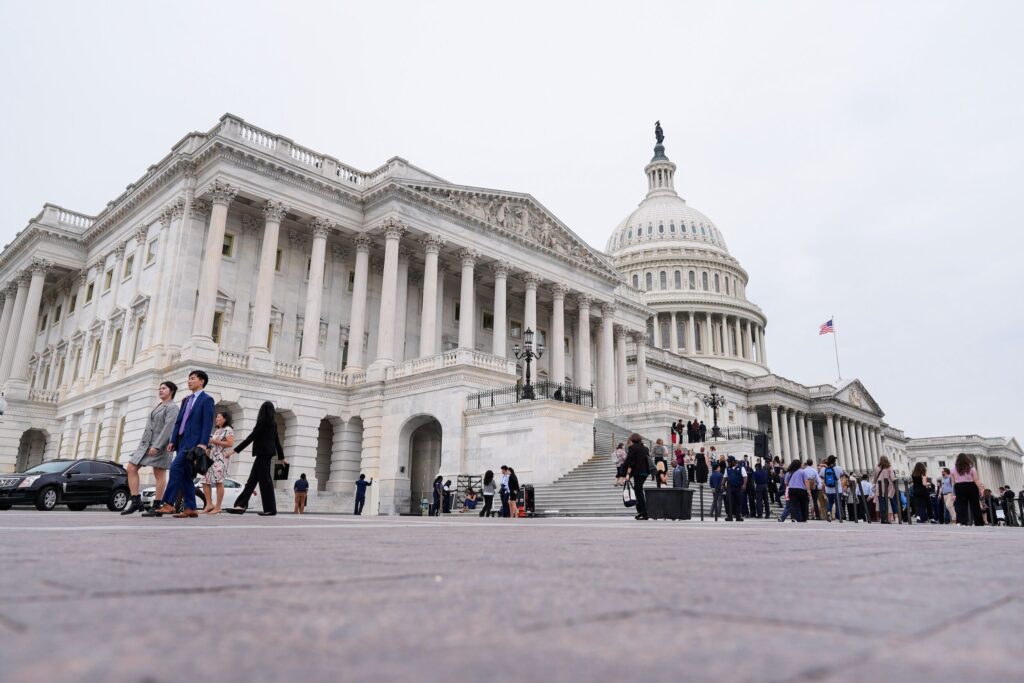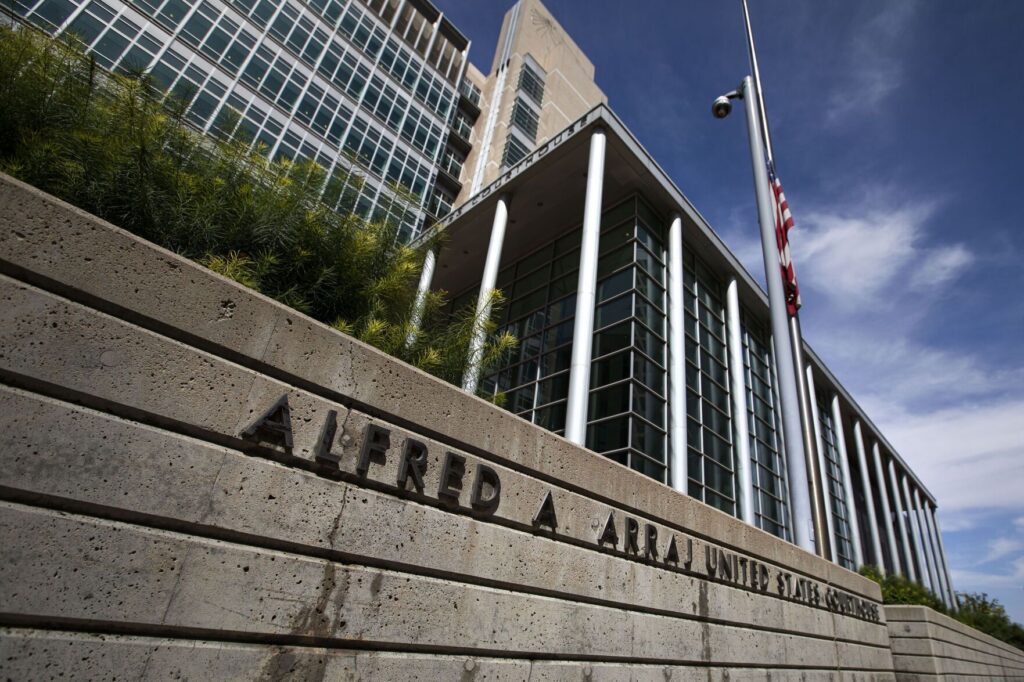YESTERYEAR: Colorado looks to solve the ‘brown cloud’ and prison reform problems
Thirty Years Ago This Week in the Colorado Statesman … According to Don Barbarick, state meteorologist with the Colorado Department of Health’s air pollution division, the Town of Parker was a relative “fail-safe area” for Denver’s “brown cloud,” the notorious billow of smog that settled across Denver’s skyline. Parker was deemed safe because of its elevation, the general direction of winds, and because the brown cloud tended to veer towards the foothills west of Parker, according to experts.
“It’s an entire metro-area problem,” said Charles Stevens, a physical scientist with the Environmental Protection Agency. “It’s not just Denver. You guys say, ‘I’ll move out and get away from it’ and pretty soon there are 10,000, 20,000, 30,000 people who move out to the same area and then you’ve got your own brown cloud.”
The brown cloud was due mainly to temperature inversions when warmer air trapped colder air along the surface of the ground, not allowing pollution to escape.
In Denver the haze was caused mostly by automobiles, Stevens said, with other contributors: diesels, power plants and wood-burning stoves. According to Jim King with the state health department’s air pollution division, 20 percent of the “brown cloud” was caused by wood-burning stoves.
In the Parker area, the only possible dangers came from the wood-burning stoves, according to King. Fireplaces and wood-stoves produce carbon monoxide and particulates, King said, which can be trapped in the lungs.
“I’ve been here for a long time,” said Stevens. “I’ve seen Parker grow. I’ve seen Boulder grow. Boulder used to say it’s all Denver’s fault. But, it’s a little of all our problem. It just tends to collect in Denver because that’s the lowest point.”
… Twenty Years Ago … State Rep. Marilyn Musgrave, R-Ft. Morgan, was the chief sponsor of House Bill 97-1198, which specified that marriages that were not between one man and one woman would not be recognized as valid in the state of Colorado, whether the deal between the love-birds was sealed inside or outside of the state of Colorado.
Before the Senate gave a 22-13 approval to the House-passed bill, Gov. Roy Romer sent a letter to all senators, urging “less divisive” language in the measure, which had been designed to forestall a possible court decision in Hawaii that would have allowed same-sex couples to marry.
Senators decided to heed Romer’s requests and removed any references to homosexuals and put the law into the “formalities of marriage” section rather than the “incest” section of the state constitution. Putting the language in the formalities section, Romer said, put same-sex couples in an unfavorable light.
But Musgrave was not prepared for such a compromise. She asked for a conference committee, declaring she would not accept the changes made by the Senate.
Two Republican senators – Ken Chlouber, R-Leadville, and MaryAnne Tebedo, R-Colorado Springs – broke party ranks and voted against the bill. Democratic Sens. Jim Rizzuto, D-La Junta, Ed Perlmutter, D-Wheat Ridge, Frank Wedding, D-Aurora, and Stan Matsunaka, D-Loveland, voted for the measure.
The measure was eventually vetoed by Romer on June 5, 1997.
… Ten Years Ago … The rising prison population, which had burdened the state budget at the expense of other programs and agencies, prompted a joint meeting between Gov. Bill Ritter’s cabinet members and Democratic lawmakers.
Sen. Abel Tapia, D-Pueblo, chairman of the Joint Budget Committee,said education was the big issue for the Democratic caucus.
“We want to put more money into education and we need to put less people into prisons,” Tapia said during the meeting which also included Lt. Gov. Barbara O’Brien and most of Ritter’s cabinet.
Administration officials said they hoped to implement comprehensive changes to the sentencing structure, programs that prevent people from ending up in prison and programs that prepare prisoners for returning to society.
“No governor in this country has a better background to address these pressing issues,” said Colorado Department of Public Safety Executive Director Pete Weir, who referred to Ritter’s former career as a Denver district attorney.
Lawmakers asked several questions of O’Brien, and the common theme among them was finding ways to reverse Colorado’s decades-long trend of putting more people in prison. From 1987 to 2007 lawmakers had lengthened prison sentences, expanded parole and lengthened the criminal code by large degree. Colorado’s prison population had grown from 10,000 in 1996 to 22,000 in 2006 and the number of people on parole had more than tripled.
Funding cuts for prevention programs from 1996-2006 had made the problem worse, said Ari Zavaras, the executive director of the Colorado Department of Corrections.
“When programs got cut, recidivism went back up,” Zavaras said. “It goes hand and glove. It’s a no-brainer.”
Zavaras added that more than 80 percent of the people in prison were there for some reason associated with drug and alcohol abuse.
Along with plans to form a sentencing commission to examine whether the laws should be changed to lessen prison terms for some crimes, Ritter had also outlined an $8 million package of budget amendments designed to boost programs that would reduce recidivism.
In 2007, Colorado was 49th among states in spending on substance abuse and mental health, Christie Donner, executive director of the Colorado Criminal Justice Reform Coalition, said. In order for the state to reach the national average, Colorado lawmakers would have had to budget an additional $40 million a year, she proclaimed.
Meanwhile the state was expected to spend an additional $51 million in 2007 on prisons to meet the demand of rising prison populations.
“We’re spending all this money to lock people up who have substance abuse problems and we’re not funding the treatments that could help straighten out their lives and keep them out of prison,” Donner said. “We have the money to do this but we have to stop spending the money on corrections.”
Sen. Sue Windels, D-Arvada, who served on the oversight committee for the state’s Mental Ill in the Criminal Justice System Task Force, said that many of the people in prison didn’t need to be there.
“Not everybody who’s locked up is a threat to somebody,” Windels said. “Many people are locked up because we don’t have the treatment and services to make them healthy.”
While the prison spending had grown, funding for higher education had shrunk. In 2001, colleges and universities accounted for 14 percent of Colorado’s general fund spending. In 2006, that had dropped to 10 percent.











